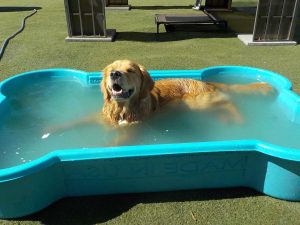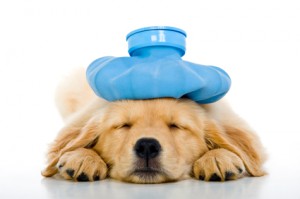Signs Of Heat Related Illness In Your Dog
Once the rainy season is over, Vancouver can get hot pretty quickly. Dogs can’t put on sunscreen, and clothes will probably add to their internal temperature.
So, what can you do to make sure your dog isn’t suffering?
First of all, you can certainly learn how to keep your dog cool. But alongside learning, you must be aware of the common symptoms that your dog may display if they have a heat-related illness.
Types of heat-related illness

DEHYDRATION
It’s not unusual for your dog to miss or drink enough water. However, as an owner, you should always monitor their levels and see if they’re drinking enough. If they aren’t drinking enough daily during the hot months, they could be dehydrated. Dehydration occurs when your dog is losing more fluid than they are con
suming.
Dehydration could be deadly as your dog’s body requires fluid to go to every area of your body to help with digestion, cushion their internal organs, lubricate joints and regulate their body temperature. While it is normal for your dog to lose and gain water throughout the day, you should be aware of the symptoms of dehydration.
Dog dehydration symptoms are the following: dry mouth, thick saliva dehydration, sticky gums, loss of appetite, sunken eyes, lethargy, and shock.
If you notice your dog experiencing any of these, take them to the vet immediately.



PAW PAD BURNS
In hot climates, some terrain can be difficult for your dog to walk on. So much that they might start to walk on the grass or in wet areas more frequently than the pavement or asphalt. While your dog’s paw pads may be tough, it’s important never to overestimate their walking abilities in hot temperatures.
If you find them walking in cooler areas, it could signify that their paw pads are burnt, which could be highly dangerou
s. In those hot months, always check the temperature of the walk before you take your dog on it. You might wish to walk them early in the morning or evening when the temperatures are cool.
You may not notice the heat transfer that much due to the protection from the shoes you’re wearing. Whereas for your dog, it’s much more painful. While some dogs do have differently structured paws, all breeds can still get burned easily. Plus, dogs often don’t realize they’ve burnt their pads till it’s too late.
If you start to notice symptoms like: refusing to walk, laying down, licking their feet, discolouration on the paw, dog missing part of paw pad, blistering, inflammation (also known as paw pad disease in dogs) and even redness, stop walking your dog immediately. Take them home, and allow them to rest to see if their symptoms subside. If they consist of longer periods, bring your dog to the vet for treatment.
.



HEATSTROKE
When your dog’s temperature is higher than usual, they can’t process bodily functions properly. This is known as heat stroke and can lead to organ failure if not treated. Heatstroke can occur if you’ve not provided your dog with enough water, left them in the car for too long on a hot day, or don’t have sufficient shade.’
It’s important to know that some breeds of dogs are more prone to heatstroke than others. Especially dogs that have thick fur, a short nose and those that have existing medical conditions.
The important signs of heatstroke are rapid panting, bright red or pale gums, thick saliva, vomiting, seizures, and dark diarrhea. These are all symptoms of heatstroke, which must be treated as soon as the symptoms are recognized.
There are many more factors that can increase the risk of heat-related illnesses in your dog, like obesity, age, environment, and even their breed. Every dog is different, and you don’t want to miss signs of your dog suffering. Do what you can to prevent heat-related illness and help your dog stay happy and healthy. If you find your dog is experiencing these symptoms, contact your vet immediately.
Commonly asked questions by dog owners:
HOW DO YOU TREAT HEATSTROKE IN DOGS?
Once you notice the signs of heatstroke in a dog -like heavy panting or excessive drooling- you will have to provide the basic first aid to your dog to avoid any emergency. The dog should immediately be moved to a shaded place away from sunlight. Secondly, place wet towels on the dog’s skin to cool him down; if possible, you can drizzle cool water on him too.
CAN A DOG SURVIVE HEATSTROKE?
The survival of your pooch after a heat stroke depends on the intensity of the stroke. If the dog’s temperature continues to rise above 103° F, he is at serious risk of organ failure. And once the vital organs are shut down, there is no coming back, and the damage is already done.
Most dogs don’t cope with a heat stroke, but if your pup is lucky enough, a 24-48 hour period is crucial to completely recover from the stroke.
WHAT CAUSES HEATSTROKE IN A DOG?
There are a lot of reasons that can lead to a stroke in dogs, but the primary reason is a lack of responsibility for the owners.–Longer periods of time in a car, shortage of proper shade in the sun, improper grooming– all these actions can cause an elevation in the dog’s temperature. Other factors that can cause a heatstroke can be obesity, old age and underlying medical conditions.
WHAT HAPPENS TO A DOG WITH HEATSTROKE?
When a dog experiences excessive hyperthermia, there is a high chance of getting a heat stroke. The heatstroke can be mild to severe, and the symptoms are according to the severity of the stroke.
Dogs with mild heat exhaustion develop heavy panting, increased drooling with thick saliva and fever, so it’s important to keep your dog cool throughout summer. In the case of severe heatstroke, the dog’s gums would turn reddish-grey or bluish; he will start to vomit and eventually, he will develop seizures and tremors.
Why would a dog not drink water?
There may be many health issues your dog might have that is causing them not to drink enough water. First of all, it could be due to a change in weather. If the weather has been hot and then got a lot cooler in temperature, they could choose to drink less.
Moreover, if they’re in a new or unfamiliar place, your dog might choose not to drink a lot of water. Your dog’s nose may be sensitive, and notice that a water bowl somewhere else may smell slightly different from what they’re used to back home. As a result, they may not feel it’s safe enough to drink.
Your dog might have an underlying health problem like a bladder infection, urinary tract infection, diabetes or kidney disease. If you notice additional symptoms combined with this, such as lethargy and lack of appetite, it’s important to inform your veterinarian.
Another reason could be due to old age. Older dogs don’t undergo the same amount of exercise as younger ones; they don’t have the energy. Therefore they might not drink as much water as previous.
Your dog could have damage to its mouth, which could make drinking water an uncomfortable experience. You should check their mouth to see if they have any rocks, splinters or plastic in there and remove it. If you can’t remove it, you might need your vet’s help to do so.
Finally, your dog could be suffering from a heat related illness.
Does wet food hydrate dogs?
Wet dog food can help keep your dog hydrated due to the high moisture content it holds. Adding wet food to their diet will complement their water intake and place less strain on important organs like the kidneys and urinary tract.
How long can my dog go without water?
On average, dogs can survive around 2-3 days with no water. However, you should never let them go without water to see how long they can manage. When your dog is dehydrated, all of its body and its processes are affected.

